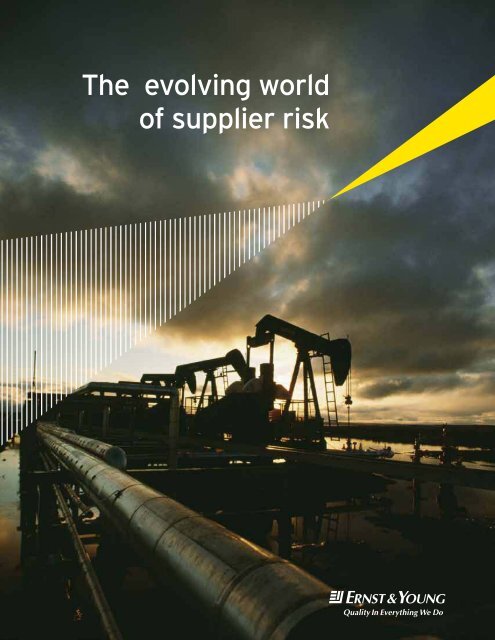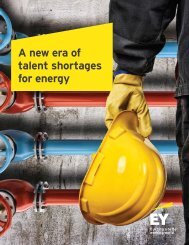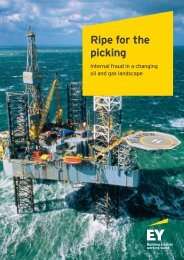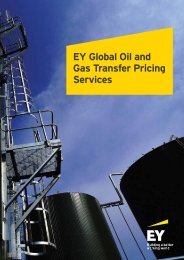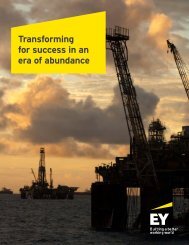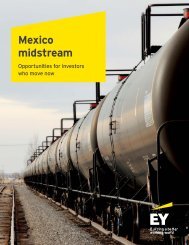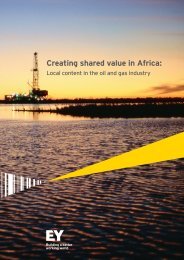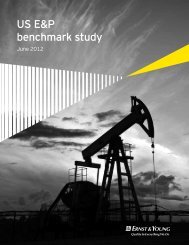The evolving world of supplier risk
The evolving world of supplier risk
The evolving world of supplier risk
You also want an ePaper? Increase the reach of your titles
YUMPU automatically turns print PDFs into web optimized ePapers that Google loves.
<strong>The</strong> <strong>evolving</strong> <strong>world</strong><br />
<strong>of</strong> <strong>supplier</strong> <strong>risk</strong>
<strong>The</strong> <strong>evolving</strong> <strong>world</strong> <strong>of</strong> <strong>supplier</strong> <strong>risk</strong><br />
Industries impacted by recent supply chain disruptions are moving<br />
quickly to improve their ability to manage procurement <strong>risk</strong>s.<br />
Oil and gas companies can learn from their experiences.<br />
By Niul Burton<br />
When the Japanese tsunami<br />
devastated that nation in 2011,<br />
the impact <strong>of</strong> the disaster was<br />
eventually felt around the <strong>world</strong>.<br />
<strong>The</strong> Japanese manufacturing<br />
industry was hard-hit, with many<br />
facilities shut down for months. In<br />
turn, auto manufacturers in Detroit<br />
and elsewhere — who rely on parts<br />
made in Japan — had no choice but<br />
to suspend production when their<br />
supply chain was disrupted.<br />
Natural disasters can have catastrophic<br />
consequences for today’s interconnected<br />
global supply network. But they are not<br />
the only <strong>risk</strong>. In the airline and aerospace<br />
<br />
have hampered the ability <strong>of</strong> manufacturers<br />
to get parts in a timely manner. And for<br />
<br />
violations surrounding their procurement<br />
activities in foreign countries have had a<br />
negative impact. <strong>The</strong>se types <strong>of</strong> disruptions<br />
<br />
<br />
long-lasting consequences.<br />
For some time, companies have approached<br />
supply chain uncertainty in a fragmented<br />
<br />
operations all working independently to<br />
manage certain aspects <strong>of</strong> <strong>supplier</strong> <strong>risk</strong>.<br />
<strong>The</strong>se unconnected activities, however<br />
successful, provide no enterprise-wide<br />
awareness or understanding <strong>of</strong> which<br />
<br />
why. By attempting to manage <strong>supplier</strong> <strong>risk</strong><br />
in functional “silos,” companies lack the<br />
overarching strategy, structure and processes<br />
to prevent a costly procurement situation.<br />
Today, however, company boards are expecting more proactive efforts, and smart companies<br />
are integrating these functional efforts to develop a holistic view <strong>of</strong> supply chain <strong>risk</strong> —<br />
identifying key gaps in the chain, monitoring potential <strong>risk</strong>s and taking mitigating measures<br />
<br />
<strong>of</strong> what natural or man-made obstacles might occur. This approach, which Ernst & Young calls<br />
Total Supplier Risk, is helping companies effectively manage all types <strong>of</strong> procurement-related<br />
<strong>risk</strong> across the breadth <strong>of</strong> their enterprise in a coordinated, strategic fashion.<br />
Supplier <strong>risk</strong>s in the energy industry<br />
Despite increasing awareness post the Macondo well blow-out <strong>of</strong> the <strong>risk</strong>s that are embedded<br />
in the supply chain, there is still a mindset in the oil and gas industry that <strong>supplier</strong> <strong>risk</strong> is just<br />
part <strong>of</strong> doing business, and managing it is a bit <strong>of</strong> an enigma.<br />
Many energy company procurement departments have never been asked to assess or quantify<br />
or manage <strong>risk</strong>. It is a skill set they haven’t developed, and doing so alone — without proven<br />
<br />
It is true that oil and gas companies operate differently than, say, an automobile manufacturer,<br />
<br />
assembly lines moving. But <strong>supplier</strong>s still play an important role in the production <strong>of</strong> energy.<br />
In fact, there are substantive <strong>supplier</strong> <strong>risk</strong>s that impact the oil and gas industry. <strong>The</strong> rapid<br />
<br />
pipe and drilling materials such as sand in several regions <strong>of</strong> the country.<br />
Of course, many energy companies do business in developing countries where major <strong>supplier</strong>s<br />
<br />
to be reliable. And insolvency <strong>of</strong> <strong>supplier</strong>s within the supply chain can be an issue even here<br />
<br />
multiple liens against a US producer who had done business with the shuttered company. It<br />
cost several million dollars to extricate the producer from the situation.<br />
Another critical issue for oil and gas companies is <strong>supplier</strong> regulatory compliance — for<br />
example, is that third-party contractor handling clean-up work following all applicable<br />
environmental statutes? Is your contractor in Nigeria following international bribery laws<br />
when it obtains licenses or permits? What due diligence did you undertake? <strong>The</strong>se are <strong>risk</strong>s<br />
<br />
<strong>The</strong> good news is that awareness <strong>of</strong> the need for improved <strong>supplier</strong> <strong>risk</strong> management is<br />
<br />
organization needs to improve existing processes or add capabilities to improve their<br />
<strong>supplier</strong> <strong>risk</strong> management. <strong>The</strong>se companies — including many in the energy industry —<br />
<br />
supply chain breakdown.<br />
<strong>The</strong> <strong>evolving</strong> <strong>world</strong> <strong>of</strong> <strong>supplier</strong> <strong>risk</strong>
Five critical areas <strong>of</strong> <strong>risk</strong><br />
Execution — Is your company in danger <strong>of</strong><br />
having to stop operations because you can’t<br />
get tools, supplies and necessary services<br />
on time at locations where you do business?<br />
Do your <strong>supplier</strong>s meet all appropriate<br />
safety and environmental regulations and<br />
provide quality goods and services?<br />
Commercial — Do your <strong>supplier</strong>s comply<br />
with all contractual terms? Do they bill you<br />
appropriately?<br />
Continuity<br />
stable? In the event <strong>of</strong> a natural disaster<br />
or other disruption, do you have multiple<br />
<strong>supplier</strong>s with geographic diversity who<br />
can keep your operations running?<br />
Competitive — Do your <strong>supplier</strong>s present<br />
<strong>risk</strong> in terms <strong>of</strong> theft <strong>of</strong> intellectual<br />
<br />
Compliance — Do your <strong>supplier</strong>s comply<br />
with critical regulatory guidelines such<br />
as the Foreign Corrupt Practices Act/<br />
UK Bribery Act, labor laws, domestic<br />
government regulations, tax laws and more?<br />
Total Supplier Risk is a program designed to<br />
recognize and eliminate avoidable <strong>risk</strong>, and<br />
reduce the impact <strong>of</strong> unavoidable <strong>risk</strong>.<br />
Procurement takes a proactive role in<br />
identifying and managing <strong>risk</strong>, and functional<br />
groups are involved in <strong>risk</strong>-event response<br />
and post-event repair to limit the impact<br />
and reduce the amount <strong>of</strong> time it takes<br />
the company to return to business as usual.<br />
In addition, <strong>risk</strong> monitoring functions,<br />
such as Internal Audit, Legal, Compliance<br />
and EHS, coordinate closely to avoid<br />
duplicative activities or, worse yet, fail to<br />
monitor controls in high <strong>risk</strong> areas. <strong>The</strong><br />
goal is to create an ongoing program that<br />
improves the company’s understanding <strong>of</strong><br />
its <strong>supplier</strong> base — and the overall operating<br />
environment — so that procurement <strong>risk</strong>s can<br />
be managed with the same level <strong>of</strong> intensity<br />
<br />
Path to maturity<br />
A comprehensive <strong>supplier</strong> <strong>risk</strong> program begins with reactive activities to manage disruptive<br />
events. A path toward achieving a comprehensive <strong>supplier</strong> <strong>risk</strong> program includes functional<br />
<br />
real-time/predictive continuous <strong>supplier</strong> <strong>risk</strong> management. Along the way, the company<br />
develops an integrated program — underpinned by technology — to measure <strong>supplier</strong><br />
performance and manage potential <strong>risk</strong>s wherever they occur. All aspects <strong>of</strong> <strong>supplier</strong> <strong>risk</strong> are<br />
covered and responsibility for monitoring and management is clearly delineated.<br />
At Ernst & Young we use an operating model to articulate all <strong>of</strong> the necessary components<br />
<strong>of</strong> an effective <strong>supplier</strong> <strong>risk</strong> management program:<br />
<br />
for TSR, including objectives,<br />
sponsorship and funding<br />
Create and apply <strong>risk</strong> mitigation<br />
and monitoring activities to<br />
ensure compliance to plan<br />
Implement the optimal<br />
approach to address<br />
each <strong>risk</strong><br />
Design TSR organization<br />
and governance,<br />
including roles and<br />
responsibilities<br />
A critical part <strong>of</strong> the process is applying tiered criteria to the company’s <strong>supplier</strong> universe to<br />
segment out by <strong>risk</strong> levels. For example, a company with 2,400 total <strong>supplier</strong>s may have 200<br />
<br />
50 with trending quality issues or liquidity concerns, and a handful that require immediate<br />
remediation or phase-out actions. Understanding which companies present the highest level<br />
<strong>of</strong> <strong>risk</strong> is critical to focusing mitigation efforts properly.<br />
Through this process, Total Supplier Risk can help companies determine which vendors require<br />
additional development support — liquidity workouts, capability development or health, safety<br />
and environmental training — and which vendors should be phased in an orderly way.<br />
<br />
dashboard views, and enable <strong>risk</strong> impact modeling, <strong>supplier</strong> <strong>risk</strong> scoring modeling and<br />
mitigation effectiveness modeling.<br />
From there, companies can create controls and processes to mitigate avoidable <strong>risk</strong>s, and<br />
develop <strong>supplier</strong> options to minimize the disruption <strong>of</strong> unavoidable ones.<br />
<strong>The</strong> <strong>evolving</strong> <strong>world</strong> <strong>of</strong> <strong>supplier</strong> <strong>risk</strong><br />
People and<br />
governance<br />
4) TSR<br />
monitoring<br />
Monitor<br />
Address<br />
Strategic<br />
direction<br />
and policysetting<br />
Processes<br />
1) Supplier<br />
segmentation<br />
Identify<br />
Assess<br />
3) Mitigation actions 2) FMEA assessment<br />
Technology<br />
enablement<br />
Segment <strong>supplier</strong>s into appropriate<br />
<strong>risk</strong> segments<br />
Vet <strong>supplier</strong>s against the relevant<br />
global procurement <strong>risk</strong> inventory<br />
Conduct failure mode and<br />
effects analysis (FMEA) on<br />
<strong>supplier</strong>s/segments and<br />
determine mitigation steps<br />
Design and<br />
implement the tools,<br />
systems and<br />
reporting to support<br />
the TSR program
<strong>supplier</strong>s are segmented into <strong>risk</strong> tiers as described above, and<br />
a failure mode and effects analysis (FMEA) is conducted on each<br />
high-<strong>risk</strong> <strong>supplier</strong>/segment. <strong>The</strong>n, mitigation options are tested and<br />
plans are implemented. <strong>The</strong> company begins its <strong>supplier</strong> monitoring<br />
activities. This serves to limit the imminent exposure.<br />
In the second phase, the operating model for Total Supplier Risk is<br />
built out as a repeatable process. <strong>The</strong> strategic direction and key<br />
<br />
developed. Technology requirements are determined. <strong>The</strong> processes<br />
<br />
ongoing monitoring <strong>of</strong> controls is established to verify that they are<br />
operating as intended.<br />
<strong>The</strong> actual detailed steps involved in Total Supplier Risk can be<br />
tailored to align with the goals <strong>of</strong> the organization. For example,<br />
an energy company that is concerned with regulatory compliance<br />
<br />
operating environment in those locations.<br />
In conclusion<br />
<strong>The</strong> issue <strong>of</strong> <strong>supplier</strong> <strong>risk</strong> is a critical one for every company that relies<br />
on <strong>supplier</strong>s, contractors or third parties for necessary products and<br />
services. Total Supplier Risk can help companies assess high-priority<br />
<br />
tested processes and capabilities going forward for recognizing and<br />
dealing with all manners <strong>of</strong> procurement issues.<br />
<strong>The</strong> result is a fully integrated <strong>risk</strong> management program that helps<br />
your company is measuring, managing and responding appropriately<br />
to the business <strong>risk</strong>s your <strong>supplier</strong>s present.<br />
Contacts:<br />
Niul Burton<br />
<br />
niul.burton@ey.com<br />
Craig Nishimura<br />
<br />
craig.nishimura@ey.com<br />
Lee Prillaman<br />
<br />
leeland.prillaman@ey.com<br />
Ernst & Young<br />
Assurance | Tax | Transactions | Advisory<br />
About Ernst & Young<br />
Ernst & Young is a global leader in assurance,<br />
tax, transaction and advisory services.<br />
<br />
by our shared values and an unwavering<br />
commitment to quality. We make a difference<br />
by helping our people, our clients and our<br />
wider communities achieve their potential.<br />
Ernst & Young refers to the global<br />
organization <strong>of</strong> member firms <strong>of</strong><br />
Ernst & Young Global Limited, each <strong>of</strong> which<br />
is a separate legal entity. Ernst & Young<br />
Global Limited, a UK company limited by<br />
guarantee, does not provide services to<br />
clients. For more information about our<br />
organization, please visit www.ey.com.<br />
Ernst & Young LLP is a client-serving<br />
member firm <strong>of</strong> Ernst & Young Global Limited<br />
operating in the US.<br />
How Ernst & Young’s Global Oil & Gas<br />
Center can help your business<br />
<strong>The</strong> oil and gas industry is constantly<br />
changing. Increasingly uncertain energy<br />
policies, geopolitical complexities, cost<br />
management and climate change all present<br />
significant challenges. Ernst & Young’s Global<br />
Oil & Gas Center supports a global practice<br />
<strong>of</strong> over 9,000 oil and gas pr<strong>of</strong>essionals with<br />
technical experience in providing assurance,<br />
tax, transaction and advisory services across<br />
the upstream, midstream, downstream<br />
and oilfield service sub-sectors. <strong>The</strong> Center<br />
works to anticipate market trends, execute<br />
the mobility <strong>of</strong> our global resources and<br />
articulate points <strong>of</strong> view on relevant key<br />
industry issues. With our deep industry<br />
focus, we can help your organization drive<br />
down costs and compete more effectively to<br />
achieve its potential.<br />
© 2012 Ernst & Young LLP.<br />
All Rights Reserved.<br />
SCORE no. DW0198<br />
WR no. 1209-1395355<br />
This publication contains information in summary form<br />
and is therefore intended for general guidance only. It<br />
is not intended to be a substitute for detailed research<br />
or the exercise <strong>of</strong> pr<strong>of</strong>essional judgment. Neither<br />
Ernst & Young LLP nor any other member <strong>of</strong> the global<br />
Ernst & Young organization can accept any responsibility<br />
for loss occasioned to any person acting or refraining from<br />
action as a result <strong>of</strong> any material in this publication. On<br />
any specific matter, reference should be made to the<br />
appropriate advisor.<br />
ED None


